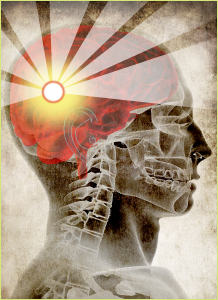Two doctors explain what you should know about traumatic brain injuries.
Most people associate the terms "brain injury" and "head trauma" with major car accidents, violent assaults, or war—not with bumping their heads on an open kitchen cabinet door, seeing stars after being tackled in a high school football game, or taking a seemingly harmless tumble on the ski slopes.
That is, until recently.
"After the Natasha Richardson tragedy, and the coverage it received, we did see a huge spike in the number of visits to the ER for head injuries," says Elizabeth Jacobs, M.D., Assistant Professor of Pediatric Emergency Medicine at Hasbro Children's Hospital in Providence, Rhode Island.
As was widely reported, the actress died in March of 2009 of a traumatic brain injury (TBI) sustained from a seemingly minor fall during a beginner's skiing lesson. Ms. Richardson, who was not wearing a helmet, didn't show any visible signs of injury after the fall and refused medical help because she said she felt fine.
Ms. Richardson's official cause of death was listed as "epidural hematoma due to a blunt impact to the head," which refers to a buildup of blood between the brain and the skull. More practically, however, her death may have been the result of Ms. Richardson, and those around her, simply not being aware of how injured she really was.
Signs of a problem
Although cases such as Ms. Richardson's are rare, it isn't unusual for head trauma to go undetected. "People don't always know what to look for because the signs can be subtle and delayed," says Neha P. Raukar, M.D., M.S., Assistant Professor of Emergency Medicine and Sports Medicine, Warren Alpert School of Medicine, Brown University.
For example, lethargy is one sign. But after a long day on the slopes, noticing that a friend who fell earlier in the day is fatigued probably doesn't raise a red flag. "They may think 'He seems overly tired, but he did ski all day, so maybe it's OK,'" Dr. Raukar says. "They may be correct in their thinking, but not necessarily."
Other signs of possible TBI include:
- Headache
- Unsteady gait
- Dizziness
- Vomiting
- Blurred vision
- Insomnia
- Confusion
- Mood changes
- Irritability
If you or someone you know exhibits any of these signs after receiving a blow to the head, seek medical attention. "Also, if someone has, say, a persistent headache after the event, it's a mistake to take pain relief medicine until it goes away," Dr. Raukar says. "That only masks the problem, which is dangerous. If the headache doesn't go away or gets worse after taking over-the-counter medication, it's time to at least start thinking that something else may be going on, especially if other symptoms of head trauma exist."
Types of head injuries
Each head injury, experts say, is as unique and individual as the victim who suffers it, and not every blow to the head is a TBI. Still, having a basic understanding of what a head injury is will make you more aware of what to look for if you or someone you know experiences a blow to the head.
"Head trauma is really any impact to the head that disrupts normal brain function," Dr. Jacobs explains, "and can result in—among other things—confusion, amnesia, loss of consciousness, intracranial bleeding, or skull fractures." In essence, when the trauma occurs, the connections between neurons, which are the nerve cells that send impulses to the brain, are adversely altered, temporarily or permanently.
The effects of head injuries can vary widely. The important thing to remember is that even without losing consciousness, the person could have experienced a severe head injury.
For severe concussions, the victim displays a wide variety of symptoms, including confusion, fogginess, and nausea, and the effects can be far reaching. This type of injury can be a lifelong condition, and individuals may need help to perform daily activities.
Don't take chances
Falls, motor vehicle accidents, sports- and recreational-related events, and assaults are the most common causes of head injuries. But everyday activities like cleaning gutters, repairing roofs, and cutting trees also account for many emergency rooms visits—as does sledding. "There's no helmet law for sledding," Dr. Raukar says, "so when these kids hit a tree—at the speeds they're going—it's like being in a car accident." And they might not tell you about it.
"Often, parents will bring a teenager in who's been complaining of a headache or has been vomiting," Dr. Jacobs explains. "We'll ask the teen if he's hit his head in the last 24 hours and when he says 'yes,' you should see the shocked looks on his parents' faces." Dr. Jacobs says teens are often reluctant to tell parents or coaches about their "head hurting" because they don't want to admit they were skateboarding without a helmet or because they don't want to be taken out of the game.
Dr. Raukar adds, "This is an unfortunate phenomenon, especially in athletes. An athlete may have hit their head but will shake it off because they want to keep playing. Therein lies the danger." She says, "Parents and coaches have to be vigilant and explain that it's not a sign of weakness to come out of a game because an athlete hit their head. Teenagers need to understand this."





